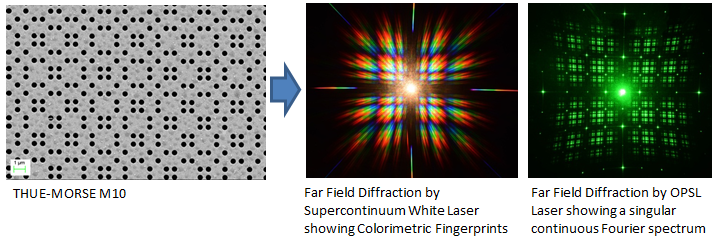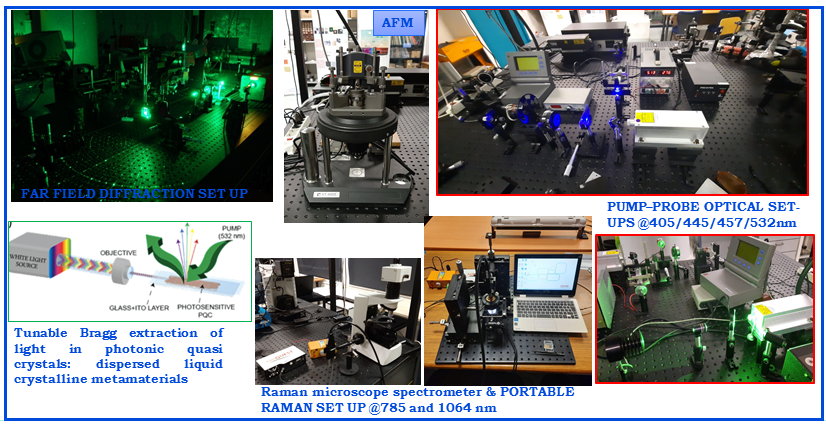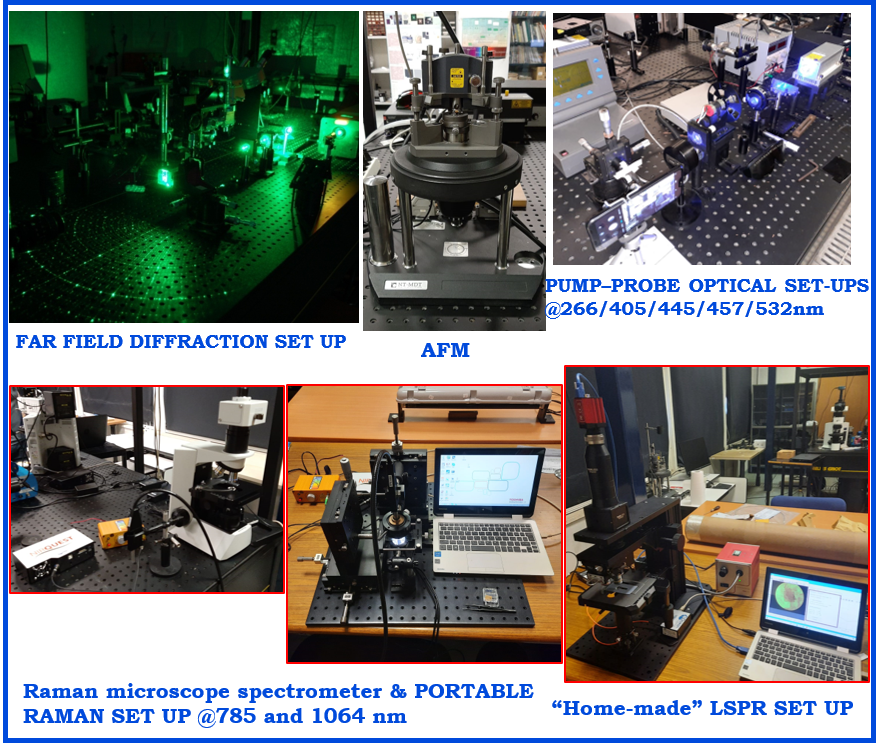Description of the activity
The activities are focalized on nanotechnologies and photonic materials and devices, on polymer-based nano systems and organic-inorganic hybrid of metallic metamaterials, in addition to optical techniques and spectroscopy to study the optical properties of materials, and to characterize devices. Spectroscopic techniques are essential tools for high sensitivity and accuracy characterizations in many sectors with high technological content (integrated optics, biotechnology, non-linear optics, quantum optics, micro- and opto-electronics, homeland-security, sensors, imaging), but the rapid evolutions in these sectors require their continuous flexible adaptation to new materials, components and devices as well as the improvement of performance (eg increase in resolution). This is of particular relevance for reliable characterizations of micro- and nano- structures which are the basis of the aforementioned devices such as for example nanobiosensors and photonic and optoelectronic devices. In particular, Smart Materials and Nanostructured Composite Materials are optically characterized for the evaluation of far and near field properties by UV-Vis-NIR spectroscopy in transmission and reflection and dark field microscopy, Raman and SERS vibrational spectroscopy (@ 785nm and 1064nm), and with polarized optical microscopy; for structural / morphological evaluation using Scanning Electron Microscopy (SEM), atomic force microscopy (AFM) and Far Field diffraction analysis.


Involved personnel
M. Rippa | V. Marchesano | A. Vestri | D. Sagnelli | L. Petti
National and International Collaborations
- Dr. Stefano Morabito (Food safety, nutrition and Veterinary Public Health Department, Istituto Superiore di Sanità);
- Dr. Giovanna Fusco (Director UOC Virologia, Istituto Zooprofilattico Sperimentale del Mezzogiorno);
- Prof. J. Zyss (ENS-Cachan, France);
- Prof. F. Simoni (Physics Dept. and Engineer of Materials of University of Marche);
- Prof. M. Brigotti (Alma Mater Studiorum – Università di Bologna, Dipartimento di Medicina Specialistica, Diagnostica e Sperimentale (DIMES));
- Prof. J. Zhou (Photonics dept. Of Ningbo University-China);
- Prof. Weijie Song (Ningbo Institute of Material Technology and Engineering-CAS Cina);
- Dr. Giuseppe Nenna (Nanomaterials and Devices Laboratory, Sustainable Materials Division, ENEA Portici Research Center);
- Prof. Antonio De Luca (Università della Calabria);
- Prof. Gustavo Ardila (Grenoble Alpes university);
- Prof. Thomas Skotnicki (Warsaw University of Technology);
- Dr. Maciej Haras (Warsaw University of Technology-CEZAMAT);
- Dr. Mateusz Wlazlo (CENTRUM BADAN I ROZWOJU TECHNOLOGII DLA PRZEMYSLU SPOLKA AKCYJNA (CBRTP S.A.);
- Dr. Frank Clayssen (CEDRAT TECHNOLOGIES SA (CTEC)).
Instrumentation/facilities
The team coordinated by Dr. Petti in ISASI-CNR is equipped with:
- 1 IOL-integrated optics laboratory which includes a total of 1 fully equipped optical bench;
- 1 NanoFab-nanoFabrication laboratory with a clean room and fully equipped with a large Facility consisting of a Raith 150 electron beam lithography system;
- 1 NanoSOFT-Nanocomposites and Soft Matter laboratory for sample preparation;
- 1 SMART Materials laboratory (chemistry lab).
In these labs, characterized by an instrumental heritage of high technological value, take place the research activities of structured researchers, post-docs and researchers from other institutions operating in the field of biology and applied optics for non-destructive control and analysis of materials, laser-matter interaction, photonics and nano-fabrication, sensors and spectroscopy for the study and characterization of materials, as part of joint research projects.
The equipment and facilities available at ISASI-CNR include:
- NanoFAB: Clean room for nanolithography: Electron Beam Lithography system RAITH 150, Scanning Electron Microscope;
- IOL: Integrated optics laboratory: Laser sources form VIS to NIR: COHERENT laser source VERDI G5 (max power 5 W, λ=532 nm), NKT broad-band laser source SuperK COMPACT (λRange = 450 nm – 2400 nm), DPSS laser source 532nm-2W (CW), LD PUMPED ALL-SOLID-STATE BLUE LASER MBL- F-457 200mW, Optical light source @405nm-200 Mw; UV-VIS portable spectrometers Ocean Optics USB4000, UV-VIS portable spectrometers FLAME-T-VIS-NIR-ES Spectrometer Assembly 350-1000nm, Olympus Microscope BX51, Integrated Raman systems QEPro with optical microscopes @785nm, Integrated Raman systems NirQuest@1064nm (NIRQUEST512: NIR Spectrometer, 900-1700nm) with optical microscope; AFM-atomic force microscopy; 3D microfabrication technologies (microMake-Laser micromachining system and Wedge UV UV sub-ns DPSS @ 266nm); Optical set-up for: a) characterization of thin films, b) plasmonic resonances evaluation of metallic nanostructures and c) Far Field Diffraction analysis of periodic and a-periodic nanostructures. High resolution and computerized handling systems; Optical spectrum analyzers; Data acquisition and analysis systems;
- NanoSOFT: Soft Matter and Nanocomposites Lab: samples preparation laboratory: Spin coater CaLCTec FR10KPA, Laminar flow cabinet, Oven, optical microscope, hot stage, Quorum Sputterer, security cupboards for chemicals etc;
- SMART Materials Lab: In the Smart Materials lab, our task is to synthesize liquid crystal based materials and novel polymers. The infrastructures present in the lab are: Chemical fumehood equipped for simple synthesis, a rotovapor, a custom machine to prepare reactors cell, balance, security cupboards for chemicals.
Active projects and contracts
- H2OSafety Project: MIUR-PROOF OF CONCEPT- 467/Ric of 02.03.2018: “Design and development of environmental sensors for the research of microbiological and chemical contaminants hazardous to health (POC01_00109)”. Duration: 07/2019-01/2023. PI: L. Petti
- STADION Project: Photometric station for in vitro diagnostic analysis. ENEA External Fund (DFM.AD001.377) – contract
- PULSE-COM project. FET Horizon 2020 Grant agreement No 863227. Duration: 12/2019-07/2023. PI: L. Petti

